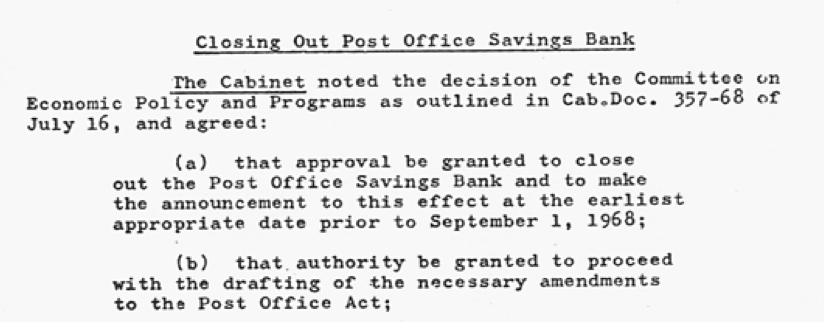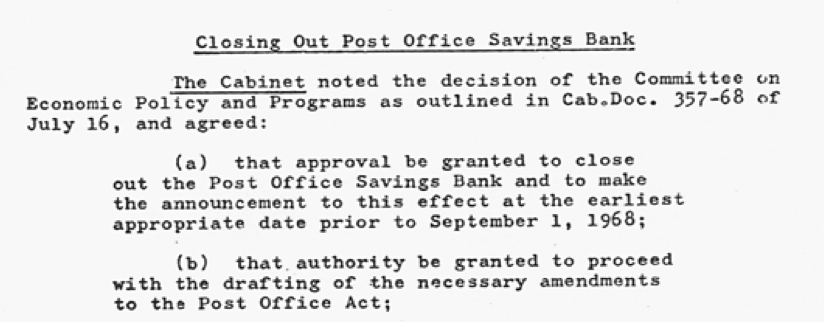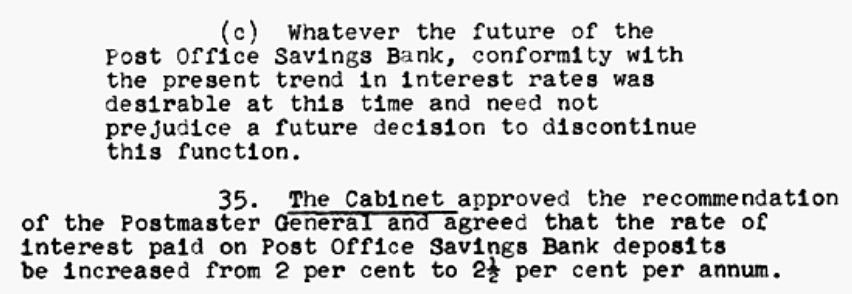I have not yet had coffee but here& #39;s a longish thread on postal banking in Canada, thrift, and account-based policy. #cdnecon #cdnpoli https://twitter.com/chambart/status/1265252673974132736">https://twitter.com/chambart/...
As the article notes, we had postal banking in Canada for a little more than 100 years. It was ended, by Cabinet decision, in 1968 and required a legislative change to the Post Office Act.
Closing down postal banking had been a debate for a very loooong time. Here& #39;s Cabinet in 1956 talking about the very same issue with Finance arguing to shut & #39;er down.
The guy responsible for the Post Office (Hughes Lapointe) argued in favour of keeping postal banking and advanced many of the same arguments made in current debate: continuity of past practice, proof of possibility from other countries, some communities not well-served by banks
I want you to pay close attention to the last word in the excerpt there: "thrift". This is key. Postal banking really offered one major service: interest-bearing deposits. And the idea of savings and "thrift" among the working classes was core to the program.
Encouraging "thrift" was a major preoccupation for policymakers for a VERY long time. Started in 19th C and kept on well into 20th. It& #39;s how, among other things we got postal banking & how the Government of Canada got into the annuities business (another thread for another day).
The US still has Thrift Savings Plans today. https://www.tsp.gov/index.html ">https://www.tsp.gov/index.htm...
Thrift was a VERY big deal. “As a guarantee of independence, the modest and plebeian quality of economy is at once ennobled and raised to the rank of one of the most meritorious of virtues.”
Thrift was a VERY big deal. “As a guarantee of independence, the modest and plebeian quality of economy is at once ennobled and raised to the rank of one of the most meritorious of virtues.”
That last is from Samuel Smiles from his imaginatively titled book "Thrift". It was part of his 19thC self-help series that included other entries such as "Duty" and "Character".
Woah...you crazy party animal!
If this all sounds kinda& #39; moralistic, it was.
Woah...you crazy party animal!
If this all sounds kinda& #39; moralistic, it was.
Thrift was evidence of moral conduct and the right motivation to NOT be reliant on others. The empirical literature on household savings has come a long way since then. There are lots of good reasons to want people to have even small savings but good morals ain& #39;t one of them.
In 1956, the rate of interest on deposits in postal banking was raised from 2 to 2.5% per annum to keep up with what regulated banks were offering. I know.. 2.5% on plain old savings accounts.. crazy!
Here& #39;s how saving in the postal bank worked: you brought your coins and bills to the local post office branch and gave them to the local postmaster who would enter your deposit in a ledger and pass your money on to HQ in Ottawa. You recorded your deposit in your passbook and
HQ would send you statements (I think just annually) on the value of your savings with annual interest credited to your account. Meanwhile, your money went into the Consolidated Revenue Fund and was used by the government like other revenue.
In fact, access to cheap money for public spending was part of the argument made by those in favour of keeping the banking service going. Admin costs in 1956 were less than 1% of the value of the ~$30M in deposits (~289M in 2020 $).
In 1956, the long-term bond rate in Canada was 3.62, so yea, <1% admin + 2.5% interest is < 3.62%.
A few more details on postal banking. The good: women could have their own bank account that they owned and controlled. The less good: getting your money out took a while. The good: they were popular with newcomers. The less good: likely because banks at the time discriminated.
Also, important to know: the people you gave your money to were public servants and all post-offices were bricks and mortar locations owned by the Crown. OTOH, local postmasters were, for a long time, appointed by political patronage (job paid well).
Ok, so back to the present day. Does the past create a proof of possibility or otherwise justify a return to postal banking? I don& #39;t get the sense that those in favour of postal banking are advocates of thrift or cheap lending to government. And I think they envision a much wider
range of products and services on offer -- just as banks are not only deposit-taking institutions. In fact post offices already do some of those other financial services like wire transfers and selling pre-loaded credit cards.
For me, the more interesting idea from the history of postal banking in Canada is that individual Canadians could have a personal relationship with government & a program could be run using individual accounts: your money disappeared into the CRF but was still credited to you.
I *think* this is how many Canadians view their EI or CPP contributions: like a deposit into a savings pool that they should be personally credited for and be able to access (but this is NOT in fact how social insurance works because of the redistributive functions).
As we think about what public policy might look like, or need to look like, I wonder whether the experience that millions have now had of logging into gov& #39;t MyAccount system & seeing money appear in their bank account will have altered public expectations in a lasting way.
And now, time for coffee!!

 Read on Twitter
Read on Twitter







